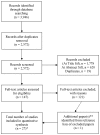Aspirin in primary prevention of cardiovascular disease and cancer: a systematic review of the balance of evidence from reviews of randomized trials
- PMID: 24339983
- PMCID: PMC3855368
- DOI: 10.1371/journal.pone.0081970
Aspirin in primary prevention of cardiovascular disease and cancer: a systematic review of the balance of evidence from reviews of randomized trials
Abstract
Background: Aspirin has been recommended for primary prevention of cardiovascular disease (CVD) and cancer, but overall benefits are unclear. We aimed to use novel methods to re-evaluate the balance of benefits and harms of aspirin using evidence from randomised controlled trials, systematic reviews and meta-analyses.
Methods and findings: Data sources included ten electronic bibliographic databases, contact with experts, and scrutiny of reference lists of included studies. Searches were undertaken in September 2012 and restricted to publications since 2008. Of 2,572 potentially relevant papers 27 met the inclusion criteria. Meta-analysis of control arms to estimate event rates, modelling of all-cause mortality and L'Abbé plots to estimate heterogeneity were undertaken. Absolute benefits and harms were low: 60-84 major CVD events and 34-36 colorectal cancer deaths per 100,000 person-years were averted, whereas 46-49 major bleeds and 68-117 gastrointestinal bleeds were incurred. Reductions in all-cause mortality were minor and uncertain (Hazard Ratio 0.96; 95% CI: 0.90-1.02 at 20 years, Relative Risk [RR] 0.94, 95% CI: 0.88-1.00 at 8 years); there was a non-significant change in total CVD (RR 0.85, 95% CI: 0.69-1.06) and change in total cancer mortality ranged from 0.76 (95% CI: 0.66-0.88) to 0.93 (95% CI: 0.84-1.03) depending on follow-up time and studies included. Risks were increased by 37% for gastrointestinal bleeds (RR 1.37, 95% CI: 1.15-1.62), 54%-66% for major bleeds (Rate Ratio from IPD analysis 1.54, 95% CI: 1.30-1.82, and RR 1.62, 95% CI: 1.31-2.00), and 32%-38% for haemorrhagic stroke (Rate Ratio from IPD analysis 1.32; 95% CI: 1.00-1.74; RR 1.38; 95% CI: 1.01-1.82).
Conclusions: Findings indicate small absolute effects of aspirin relative to the burden of these diseases. When aspirin is used for primary prevention of CVD the absolute harms exceed the benefits. Estimates of cancer benefit rely on selective retrospective re-analysis of RCTs and more information is needed.
Conflict of interest statement
Figures



References
-
- Bloom DE, Cafiero E, Llopis EJ, Abrahams-Gessel S, Bloom LR et al. (2012). The Global Economic Burden of Noncommunicable Diseases. PGDA Working Papers 8712 Program on the Global Demography of Aging.
-
- Belch J, MacCuish A, Campbell I, Cobbe S, Taylor R et al. (2008) The prevention of progression of arterial disease and diabetes (POPADAD) trial: factorial randomised placebo controlled trial of aspirin and antioxidants in patients with diabetes and asymptomatic peripheral arterial disease. BMJ 337: a1840. doi:10.1136/bmj.a1840. PubMed: 18927173. - DOI - PMC - PubMed
-
- Hansson L, Zanchetti A, Carruthers SG, Dahlöf B, Elmfeldt D et al. (1998) Effects of intensive blood-pressure lowering and low-dose aspirin in patients with hypertension: principal results of the Hypertension Optimal Treatment (HOT) randomised trial. HOT Study Group. Lancet 351: 1755-1762. doi:10.1016/S0140-6736(98)04311-6. PubMed: 9635947. - DOI - PubMed
Publication types
MeSH terms
Substances
LinkOut - more resources
Full Text Sources
Other Literature Sources
Medical
Miscellaneous

